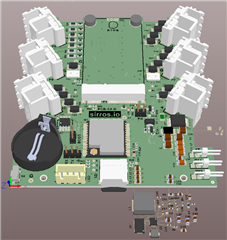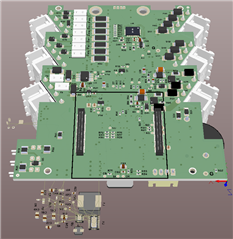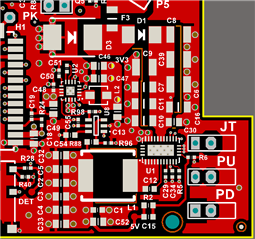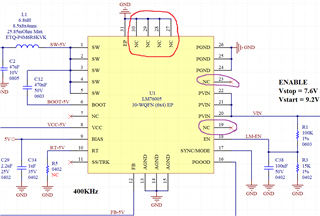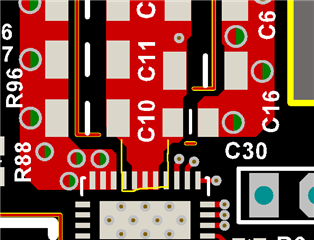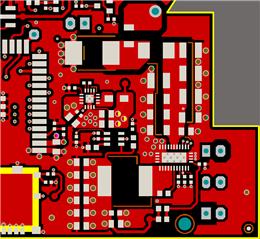Other Parts Discussed in Thread: SN65HVD1781, TPS2491, CSD19537Q3, TPS62091, LMR16030, ,
Hi.
We are developing a board layout which already has these parts from TI:
1x SN65HVD1781
2x TPS2491
2x transistor CSD19537Q3
The board will be supplied by industrial power supplies, 24V nominal. Before, the buck converter was a LMR16030 with 3.3V output, but I changed it by a LM76005 because we will try to add compatibility with Raspberry Pi Compute Module 3 and 4 to it, so I needed to change the main power supply output to 5V using LM76005, because it has more output current capacity, then I'm going to reduce that 5V to 3V3 by using a TPS62091. I need 5V and 3V3 in my circuit.
Please, could I receive an analysis from TI engineers in my schematics and calculations?
(1) About the TPS62091, here is the Webench design, the inductor I chose is exactly the one suggested on the Webench design.
(2) Here are the calculations I did for LM76005 (5V output) until now. OBS: The fact is that in practice, this 5V output will never reach 4A average current consumption.
LM76005, Vout of 5V x 5A, Vin of 10 to 40V, 400KHz
------------------------------------
FEEDBACK RESISTORS
------------------------------------
Vin = 10~40V
Vout = 5V
Iout = 5A
Vfb = 1.006V
Resistors = 100K/24.9K
Vout Typ = 1.006+1.006*(100/24.9) = 5.04V
Vout Max = 1.017+1.017*((100*1.01)/(24.9*0.99)) = 5.18V
Vout Min = 0.987+0.987*((100*0.99)/(24.9*1.01)) = 4.87V
------------------------------------
SOFT-START CAPACITOR
------------------------------------
Pin SS/TRK left floating.
Leave this pin floating to use the 6.3ms internal soft-start ramp
------------------------------------
UVLO/ENABLE
------------------------------------
Connections: VIN - RenT - ENABLE - RenB - GND
RenB = (VEN_VOUT_H * RenT) / (VIN_ON_H - VEN_VOUT_H)
VEN_VOUT_H Typ = 1.204V
VIN_ON_H = 9.2V
RenT = 100K 0603 1%
RenB = (1.204 * (100)) / (9.2 - 1.204)
RenB = 15.05K
RenB = 15K 0402 1%
VIN-UVLO-RISING = VENH * (RENB + RENT) / RENB
VIN-UVLO-RISING = 1.204 * (15 + 100) / 15
VIN-UVLO-RISING = 9.23V
VIN-UVLO-FALLING = VENL × (RENB + RENT) / RENB
VIN-UVLO-FALLING = 0.99 * (15 + 100) / 15
VIN-UVLO-FALLING = 7.6V
------------------------------------
SWITCHING FREQUENCY
------------------------------------
RT pin. If floating, the default switching frequency is 400 kHz.
Place a resistor in the layout but do not mount it, at RT pin.
------------------------------------
DUTY
------------------------------------
Dmin = tON-min * fsw
Dmin = (70*10^-9) * (400*10^3)
Dmin = 0.028 (2.8%)
Dmax = 1 - (tOFF-min * fsw)
Dmax = 1 - ( (100*10^-9) * (400*10^3) )
Dmax = 0.96 (96%)
Vin Max and Vin Min.
The maximum operational supply voltage can be found by:
VinMax = Vout / (fsw * tON-min)
VinMax = 5 / ( (400*10^3) * (70*10^-9) )
VinMax = 178V
The minimum VIN without frequency foldback can be approximated by:
VinMin = Vout / (fsw * tOFF-min)
VinMin = 5 / ( (400*10^3) * (100*10^-9) )
VinMin = 125V
------------------------------------
INDUCTOR SELECTION EQUATIONS
------------------------------------
deltaIL = ( (Vin - Vout) * D ) / (L * fsw)
L >= ( (Vin-Vout) * D ) / (0.4 * fsw * I-load-max)
L<= ( (Vin-Vout) * D ) / (0.2 * fsw * I-load-max)
Inductor saturation-current rating.
ILpeak = I-load-max + (deltaIL / 2)
D ~= Vout / Vin
------------------------------------
INDUCTOR SELECTION CALCULATIONS
------------------------------------
Vin = 40V
Vout = 5V
D ~= 5/40
L >= ( (Vin-Vout) * D ) / (0.4 * fsw * I-load-max)
L >= ( (40-5) * 5/40 ) / (0.4 * (400*10^-3) * 5)
L >= 5.46uH
L<= ( (40-5) * 5/40 ) / (0.2 * (400*10^-3) * 5)
L<= 10.93uH
L range = 5.46uH to 10.93uH
* On the tag of the product will be specified a voltage supply range from 12V to 38V.
* On great majority of the cases the supply input will be 24V, from a industrial power supply.
* In history, we have seen only few industrial power supplies, of old machinery, delivering 36V at the maximum.
* Chosen inductor = IHLP3232DZER6R8M11 (Vishay):
- 6.8uH +- 20% (6.8uH * 0.8 = 5.44uH)
- Irating = 7A, Isat = 6.7A
- DCR = 33.4mOhm max
deltaIL = ( (Vin - Vout) * D ) / (L * fsw)
deltaIL = ( (40 - 5) * 0.125 ) / ( (6.8*10^-6) * (400*10^3) )
deltaIL = 1.6A
ILpeak = I-load-max + (deltaIL / 2)
ILpeak = 5 + (1.6 / 2)
ILpeak = 5.8A
------------------------------------
FEEDFORWARD CAPACITOR
------------------------------------
FX = 15.46 / (Vout * Cout)
FX = 15.46 / ( 5 * 6 * (47*10^-6) )
FX = 10.964 KHz
CFF = ( 1 / (2*pi*FX) ) * ( 1 / ( sqrt ( RFBT * (RFBT // RFBB ) ) ) )
CFF = ( 1 / (2*pi*FX) ) * ( 1 / sqrt ( RFBT * (RFBT * RFBB / (RFBT + RFBB) ) ) )
CFF = ( 1 / (2*pi*10.964*10^3) ) * ( 1 / sqrt ( 100000 * (100000 * 24900 / (100000 + 24900) ) ) )
CFF = 3.25 * 10^-10
CFF = 325pF
CFF = 330pF
For the current 6.8uH inductor, I don't wanted to use a bigger physical size inductor (with bigger area), because space is so much 'at a premium'.
Suggestions and recommendations from TI engineers?
Regards.
